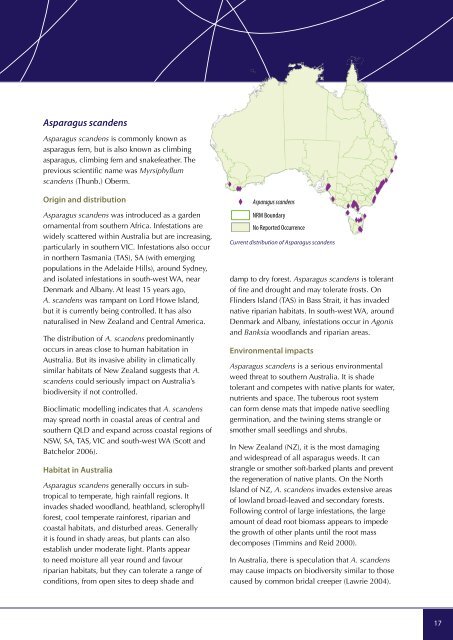Asparagus weeds - Weeds Australia
Asparagus weeds - Weeds Australia
Asparagus weeds - Weeds Australia
- No tags were found...
Create successful ePaper yourself
Turn your PDF publications into a flip-book with our unique Google optimized e-Paper software.
<strong>Asparagus</strong> scandens<strong>Asparagus</strong> scandens is commonly known asasparagus fern, but is also known as climbingasparagus, climbing fern and snakefeather. Theprevious scientific name was Myrsiphyllumscandens (Thunb.) Oberm.Origin and distribution<strong>Asparagus</strong> scandens was introduced as a gardenornamental from southern Africa. Infestations arewidely scattered within <strong>Australia</strong> but are increasing,particularly in southern VIC. Infestations also occurin northern Tasmania (TAS), SA (with emergingpopulations in the Adelaide Hills), around Sydney,and isolated infestations in south-west WA, nearDenmark and Albany. At least 15 years ago,A. scandens was rampant on Lord Howe Island,but it is currently being controlled. It has alsonaturalised in New Zealand and Central America.The distribution of A. scandens predominantlyoccurs in areas close to human habitation in<strong>Australia</strong>. But its invasive ability in climaticallysimilar habitats of New Zealand suggests that A.scandens could seriously impact on <strong>Australia</strong>’sbiodiversity if not controlled.Bioclimatic modelling indicates that A. scandensmay spread north in coastal areas of central andsouthern QLD and expand across coastal regions ofNSW, SA, TAS, VIC and south-west WA (Scott andBatchelor 2006).Habitat in <strong>Australia</strong><strong>Asparagus</strong> scandens generally occurs in subtropicalto temperate, high rainfall regions. Itinvades shaded woodland, heathland, sclerophyllforest, cool temperate rainforest, riparian andcoastal habitats, and disturbed areas. Generallyit is found in shady areas, but plants can alsoestablish under moderate light. Plants appearto need moisture all year round and favourriparian habitats, but they can tolerate a range ofconditions, from open sites to deep shade andX<strong>Asparagus</strong> scandensNRM BoundaryNo Reported OccurrenceCurrent distribution of <strong>Asparagus</strong> scandensdamp to dry forest. <strong>Asparagus</strong> scandens is tolerantof fire and drought and may tolerate frosts. OnFlinders Island (TAS) in Bass Strait, it has invadednative riparian habitats. In south-west WA, aroundDenmark and Albany, infestations occur in Agonisand Banksia woodlands and riparian areas.Environmental impacts<strong>Asparagus</strong> scandens is a serious environmentalweed threat to southern <strong>Australia</strong>. It is shadetolerant and competes with native plants for water,nutrients and space. The tuberous root systemcan form dense mats that impede native seedlinggermination, and the twining stems strangle orsmother small seedlings and shrubs.In New Zealand (NZ), it is the most damagingand widespread of all asparagus <strong>weeds</strong>. It canstrangle or smother soft-barked plants and preventthe regeneration of native plants. On the NorthIsland of NZ, A. scandens invades extensive areasof lowland broad-leaved and secondary forests.Following control of large infestations, the largeamount of dead root biomass appears to impedethe growth of other plants until the root massdecomposes (Timmins and Reid 2000).In <strong>Australia</strong>, there is speculation that A. scandensmay cause impacts on biodiversity similar to thosecaused by common bridal creeper (Lawrie 2004).17
















